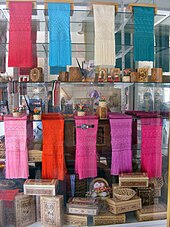Rebozo

The word rebozo refers to a Mexican garment for women. It is rectangular, made of cotton, silk or articele and has a size between one and a half and three meters. A rebozo can be worn as a scarf or headscarf, but it is also often used to carry children or goods. There are very different qualities from very cheap to pieces that cost several hundred euros.
Rebozos presumably originated from the mixing of the Spanish colonial culture with that of the indigenous peoples of Mexico. It is not known whether these rebozos were used before the arrival of the Spaniards, but it is certain that the word did not enter the Spanish language until 1562. A certain influence of Filipino culture on the style of the garment is also possible.
The production takes place mostly in Mexico, whereby the products from Michoacán , Oaxaca , Querétaro and San Luis Potosí are particularly well known. In the latter region - which is known for the weaving of the Otomí - the most expensive Rebozos Caramelos are made. While single-colored, simple Rebozos Chalinas are called, multi-colored ones are often kept in the national colors red, green and white.
As a typical Mexican item of clothing, the rebozo is often part of traditional costumes and is often used as a metaphor in art. For example, Frida Kahlo often portrayed himself with Rebozo and Agustín Casasola depicts Soldaderas - soldiers of the Mexican Revolution - with Rebozos de Bolita in his photographs .
Web links
- Making a Rebozo. (English)
- The Rebozo Way Project. (English)
